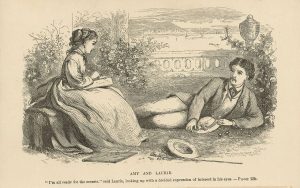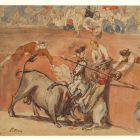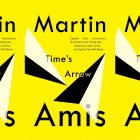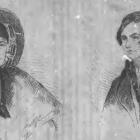The Age Gap in 19th Century Literature
 In a recent op-ed for the NY Times, statistics-obsessed Mona Chalabi laid out the age gap in attraction between heterosexual men and women. Culled primarily from OK Cupid’s online data, the piece states that as women age, they examine the dating profiles of their contemporaries, while men, no matter their ages, peruse photos of women in their early 20’s. This leads to the man in most romantic duos to be an average 2.3 years older than the woman.
In a recent op-ed for the NY Times, statistics-obsessed Mona Chalabi laid out the age gap in attraction between heterosexual men and women. Culled primarily from OK Cupid’s online data, the piece states that as women age, they examine the dating profiles of their contemporaries, while men, no matter their ages, peruse photos of women in their early 20’s. This leads to the man in most romantic duos to be an average 2.3 years older than the woman.
If the literary novel can turn measuring stick, the 19th century looks a lot like Chalabi’s 21st century as far as data goes. The most famous novels of the period feature May-December romances like The Portrait of a Lady, Middlemarch, and Little Women; however, not without an interlude with a fellow May appearing somewhere in the story.
The Victorian era circled around money and fertility: A man was desirable once he’d acquired wealth, a woman for her ability to bear children. Most men tend to amass money later in life, and birthing several babies is still a moderately young woman’s game. As online data reveals, this paradigm remains in tact, though perhaps for different reasons.
Isabel Archer makes a similarly advantageous marriage to Gilbert Osmond in Henry James’s Portrait. James’s Osmond is not without his charms, though they curl around an underlying narcissism: “Under all his culture, his cleverness, his amenity, under his good-nature, his facility, his knowledge of life, his egotism lay hidden like a serpent in a bank of flowers.”
The brawny Caspar Goodwood is the more age appropriate counterpoint to Osmond (who has a teenaged daughter). James ends the novel ambiguously, though Goodwood’s supplication for Isabel to “be mine as I’m yours!” can’t be misunderstood. The reader is left to wonder what things would be like had she chosen Goodwood over Osmond. Booker Prize winner, John Banville, recently released a sequel titled Mrs. Osmond to continue Isabel’s quest for fulfillment.
Dorothea Brooke falls for the older clergyman Casaubon in George Eliot’s Middlemarch, envisioning a life of thoughtful study and seeing him pen a compendium of world mythology. His great work never materializes, and he dies before novel’s end, freeing her up to be with Will Ladislaw, a fiery young painter who worships her. Rather than leaving them in the narrative dark like Isabel, Eliot lets readers witness Dorothea’s happiness, leaving them with the feeling that “one can begin so many things with a new person!”
Perhaps one of the most contentious couplings in well-loved literature is that of Jo March and Professor Bhaer in Louisa May Alcott’s Little Women. (For a detailed unpacking of this wise German gent, see Sadie Stein’s wry posts in The Paris Review online.) “He isn’t old,” Jo reassures her family in the book. Still, readers are well aware of the age difference between him and the exuberant childhood friend Laurie. The romance between Jo and the prof pans out okay: the sequel Little Men details their business venture as heads of a boys’ school.
Professor Bhaer suggests stability of one form or another, whereas Laurie and Jo probably would have gallivanted around Europe together, living cultured lives shaped like question marks. What’s so bad about that? Says Team Laurie. This is literature—not life.
Across all three books, the heroine chooses the older, more mature mate; however, before, during, or after, she acknowledges the romantic contemporary—the wild card.
Perhaps this is the takeaway from OK Cupid’s online data: Younger women choose older men because of the promise of stability (financial or otherwise), the guarantee of staring into life’s box of chocolates and magically knowing which one is filled with smooth caramel in order to avoid the square stuffed with powdery pink fruit.
Though sometimes if you’re lucky, the pink filling turns out to be raspberry, it’s delicious, and just what you wanted along.



